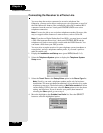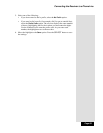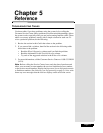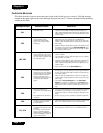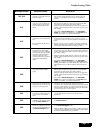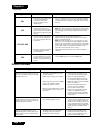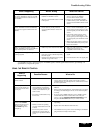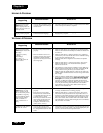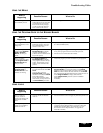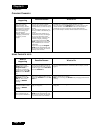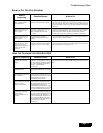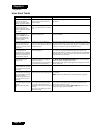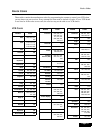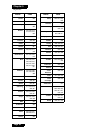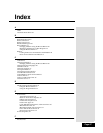
Page 76
Reference
Chapter 5
HEARING A PROGRAM
WATCHING A PROGRAM
What Is
Happening
Possible Reason What to Do
The receiver front panel
Power light is on and
there is a good picture on
the TV set, but you do not
hear any sound.
• You may have muted the sound,
or set the volume so low that you
cannot hear it.
• Check the volume level on the TV or audio device. Turn off the
mute or turn up the volume, as required.
You hear a foreign
language with a program.
• You may have set the receiver to
an alternate audio language.
•Use the Alternate Audio Language menu to select the
language that you prefer.
What Is
Happening
Possible Reason What to Do
The receiver front panel
Power light is on, but the
TV image:
is black (no picture),
is frozen,
has breakups,
has “snow,” or
shows small squares of
various colors.
• The TV set may not be working
properly.
• If the TV and the receiver are
working properly, there may be
interference with the satellite
signal. The TV may be wired to
the wrong input.
• Make sure that the TV set is plugged into an electrical outlet.
Make sure the outlet has electrical power. Make sure that the TV
is turned on.
• Make sure that the TV is tuned to channel 3 or 4 (whichever
works best in your area) and that the receiver modulator setting
is set to the same channel as the TV.
Make sure that the TV brightness and contrast are adjusted
correctly.
• Make sure that the TV is connected properly to the receiver.
Make sure that the TV’s text mode and closed captioned
features are turned off.
• Check that the system has been installed correctly. Make sure
that all required coaxial cables are in place, and check that all
cable connectors are tight and dry (for outdoor cables).
Make sure that the satellite dish has a clear line of sight to the
satellite. Check whether branches or leaves have grown into the
line of sight.
• Make sure that the satellite dish is aimed at the satellite. Check
the strength of the signal using the Point Dish and Signal
Strength menu. Consult your installer to re-aim the dish, if
necessary, to obtain the maximum possible signal strength.
Note the local weather conditions. Heavy rain, snow, or cloud
cover may be interfering with transmission of the satellite
signal. Remove any snow or other debris which may have
collected on the satellite dish.
The receiver front panel
Power light is on, and
there is a picture on the
TV screen, but the picture:
has sparkles or is grainy,
has a herringbone pattern,
lacks color or vertical
hold, or wobbles, or
looks “washed out” or
fuzzy.
• The TV set may not be working
properly.
• There may be a strong local
broadcast on the same channel,
or a channel adjacent to the one
to which the TV is tuned.
There may be interference from
other nearby electrical devices
(such as cellular telephones,
computers, microwave ovens,
radios, stereos, or TVs).
• Make sure that the TV brightness and contrast are adjusted
correctly, and that the TV is working properly.
• Make sure that the TV is connected properly to the receiver.
Check other nearby electrical devices as possible sources of
interference. Check that all required coaxial cables are in place.
Check for moisture or water leaking into all connections. Dry
them out if needed, then seal them with coaxial cable sealant.
Check the dish-to-receiver cable run length; if it is over 200 feet,
call your dealer or installer.
A “black box” fills almost
all of the TV screen.
• You may have turned on the
Closed Captioned feature on the
TV, and put that feature into Text
mode.
• Using the TV remote control and/or menus displayed by the TV
(not the receiver remote control or the menus displayed by the
receiver), turn off the closed captioned feature.



